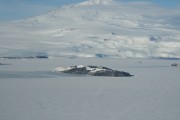This is the 26th entry in the Armed with Science series, Dispatches from Antarctica. The series features Air Force Lt. Col. Ed Vaughan’s first-hand experiences on OPERATION: DEEP FREEZE, the Defense Department’s support of National Science Foundation research in Antarctica.
27 Oct, McMurdo Station, Antarctica: More LC-130s arrive
Skier 94, callsign for the second of the LC-130s, arrived at McMurdo today. Two other LC-130s, an Australian Airbus A319, and the C-17 all canceled their flights due to poor weather. Skier 94 got lucky with a weather window that opened just enough to accommodate their arrival. By the time the other aircraft were scheduled to launch, today’s weather window was closed shut.
Riding along on today’s LC-130 was a much needed contingent of New York Air National Guard aircraft maintenance troops. These are the hardy men and women of the 109th Airlift Wing who will work 12-16 hour shifts every day down at the seasonal ice runway. They will primarily work outside in the razor cold wind. There are no hangars here. The planes are out in the open. Even the maintenance offices and warming huts, sometimes half a mile away, look like big refrigerators.

The view from an LC-130 cockpit on the approach into McMurdo’s Seasonal Ice Runway. (Photo: Maj Dave Panzera/USAF).
The parts that these fixers-of -airplanes will handle are mostly metal. The parts are often coated with machine liquids like oil, hydraulic fluid, and sometimes fuel. This super-cooled combination can impart contact frostbite in seconds. Maintainers often need fine tactile sensitivities, though, and sometimes cut the fingertips off their gloves. It’s the only way to get some repairs done, despite the risk. Good cold weather survival awareness, and prudent application of appropriate work-rest warming cycles, helps these total force Airmen get the Skibirds ready for flight.
Typically, aircraft forward deploying to Antarctica will suffer a couple small leaks and require a few cold weather adjustments upon arrival. However, Skier 94 is the second LC-130 in a row to land with a troubling “propeller oil” leak. Still using the older 4-bladed propellers, these LC-130s may need complete propeller changes before they’re fit to fly again. Unfortunately, these planes are not equipped with the new 8-bladed propeller design which makes such maintenance issues easier and quicker to address. That equates to a long night for the propulsion mechanics…assuming spare propellers and mechanics were even on the plane.
With a long history of keeping LC-130 downtime to a minimum, I expect these maintainers will rise to the occasion and get all the planes flying in time for the next schedule. But it won’t be easy, or comfortable. I’ll dedicate a future blog to the work of this intrepid crew.
Thanks to US Air Force Maj Dave Panzera for providing the raw video footage and photos.













